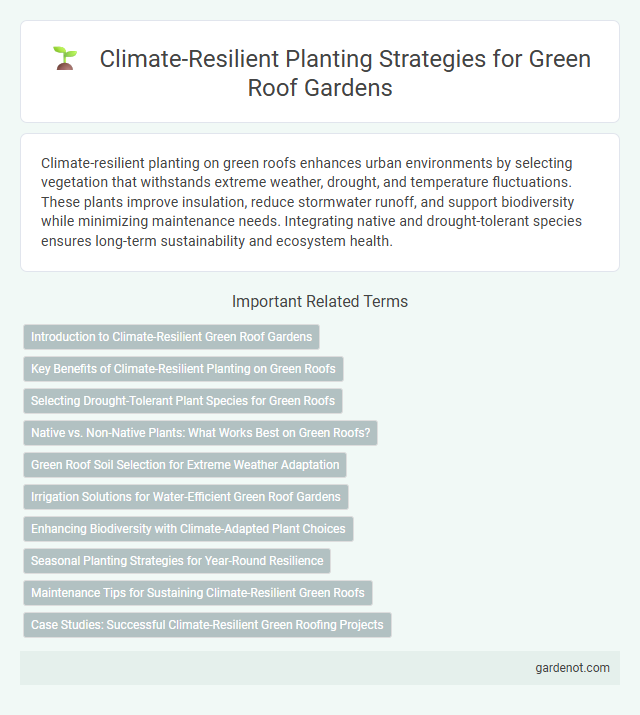Climate-resilient planting on green roofs enhances urban environments by selecting vegetation that withstands extreme weather, drought, and temperature fluctuations. These plants improve insulation, reduce stormwater runoff, and support biodiversity while minimizing maintenance needs. Integrating native and drought-tolerant species ensures long-term sustainability and ecosystem health.
Introduction to Climate-Resilient Green Roof Gardens
Climate-resilient green roof gardens utilize drought-tolerant and native plant species that thrive in extreme weather conditions, enhancing urban heat island mitigation and stormwater management. These green roofs improve air quality by filtering pollutants and provide insulation benefits, reducing building energy consumption. Integrating diverse, climate-adaptive vegetation supports urban biodiversity while ensuring the durability and functionality of rooftop ecosystems amid climate change challenges.
Key Benefits of Climate-Resilient Planting on Green Roofs
Climate-resilient planting on green roofs enhances urban heat island mitigation by maintaining plant health under extreme temperatures and fluctuating weather patterns. These plants improve stormwater management through increased water retention and reduced runoff, supporting sustainable urban drainage systems. Furthermore, they promote biodiversity and air quality by providing habitats and filtering pollutants in densely built environments.
Selecting Drought-Tolerant Plant Species for Green Roofs
Selecting drought-tolerant plant species for green roofs enhances climate resilience by reducing water dependence and improving survival rates during prolonged dry periods. Native succulents, ornamental grasses, and hardy perennials are ideal choices due to their low water needs and ability to withstand high temperatures. Incorporating these species supports sustainable urban green infrastructure by minimizing irrigation requirements and promoting biodiversity.
Native vs. Non-Native Plants: What Works Best on Green Roofs?
Climate-resilient planting on green roofs benefits significantly from using native plants due to their adaptability to local weather patterns, soil conditions, and native fauna interactions, leading to improved survival rates and ecosystem support. Non-native plants may offer aesthetic variety but often require more maintenance, water, and protection against pests, reducing sustainability. Research from the Green Roof Technology center emphasizes biodiversity, drought tolerance, and minimal irrigation as key criteria, with native species outperforming non-natives in long-term resilience and environmental benefits.
Green Roof Soil Selection for Extreme Weather Adaptation
Selecting green roof soil with high water retention and excellent drainage properties is crucial for climate-resilient planting, especially in adapting to extreme weather conditions. Utilizing engineered soil mixes rich in organic matter enhances moisture availability during droughts while preventing waterlogging during heavy rainfall. Incorporating lightweight, nutrient-dense substrates supports robust plant growth and improves thermal regulation, ultimately increasing the green roof's durability and ecological function.
Irrigation Solutions for Water-Efficient Green Roof Gardens
Climate-resilient planting on green roofs relies heavily on advanced irrigation solutions to optimize water efficiency and ensure plant survival during drought conditions. Techniques such as drip irrigation systems and moisture sensors precisely deliver water only when necessary, significantly reducing water waste and promoting sustainable urban ecosystems. Implementing these smart irrigation strategies enhances green roof performance by maintaining healthy vegetation and mitigating heat island effects.
Enhancing Biodiversity with Climate-Adapted Plant Choices
Climate-resilient green roofs utilize climate-adapted plant species that thrive under local weather extremes, enhancing biodiversity by supporting native pollinators and wildlife. Selecting drought-tolerant, heat-resistant, and wind-adapted plants ensures long-term vegetation survival and ecosystem stability. These strategic plant choices contribute to urban habitat diversity, mitigate heat island effects, and improve stormwater absorption.
Seasonal Planting Strategies for Year-Round Resilience
Climate-resilient green roofs utilize seasonal planting strategies that adapt to changing weather patterns, ensuring year-round vegetation coverage and ecosystem benefits. Selecting native perennials and drought-tolerant species improves water retention and reduces soil erosion during extreme weather events. Implementing a mix of early bloomers and late-season plants maximizes biodiversity and sustains habitat for pollinators across all seasons.
Maintenance Tips for Sustaining Climate-Resilient Green Roofs
Climate-resilient green roofs require regular maintenance such as seasonal pruning, weed control, and irrigation monitoring to ensure plant health and water efficiency. Selecting drought-tolerant and native plant species reduces the need for excessive watering and enhances resistance to local climate stressors. Routine inspections for drainage system functionality prevent waterlogging and structural damage, sustaining the roof's ecological and thermal performance.
Case Studies: Successful Climate-Resilient Green Roofing Projects
Case studies of climate-resilient green roofing projects, such as the Chicago City Hall green roof and the Freiburg Solar Settlement, demonstrate the significant benefits of drought-tolerant native plants and robust soil substrates in urban environments. These projects showcase reduced urban heat island effects, improved stormwater retention, and enhanced biodiversity, proving the viability of green roofs under extreme weather conditions. The integration of smart irrigation systems and adaptive plant species selection has led to resilient ecosystems that withstand prolonged heat and variable precipitation patterns.
Climate-resilient planting Infographic

 gardenot.com
gardenot.com